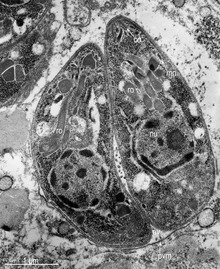Rhoptry

Tachyzoites of Toxoplasma gondii, transmission electron microscopy.[1] Rhoptries: ro (click to enlarge)
A rhoptry is a specialized secretory organelle. They are club-shaped organelles connected by thin necks to the extreme apical pole of the parasite. These organelles, like micronemes, are characteristic of the motile stages of Apicomplexa protozoans. They can vary in number and shape and contain numerous enzymes that are released during the penetration process. The proteins they contain are important in the interaction between the host and the parasite, including the formation of the parasitophorous vacuole.[2][3]
References[]
- ^ Rigoulet, Jacques; Hennache, Alain; Lagourette, Pierre; George, Catherine; Longeart, Loïc; Le Net, Jean-Loïc; Dubey, Jitender P. (2014). "Toxoplasmosis in a bar-shouldered dove (Geopelia humeralis) from the Zoo of Clères, France". Parasite. 21: 62. doi:10.1051/parasite/2014062. ISSN 1776-1042. PMC 4236686. PMID 25407506.
- ^ Bradley, Peter J; Chris Ward; Stephen J. Cheng; David L. Alexander; Susan Coller; Graham H. Coombs; Joe Dan Dunn; David J. Ferguson; Sanya J. Sanderson; Jonathan M. Wastling; John C. Boothroyd (October 7, 2005). "Proteomic Analysis of Rhoptry Organelles Reveals Many Novel Constituents for Host-Parasite Interactions in Toxoplasma gondii". J. Biol. Chem. 280 (40): 34245–34258. doi:10.1074/jbc.M504158200. PMID 16002398.
- ^ Richard, D; et al. (March 2009). "Identification of rhoptry trafficking determinants and evidence for a novel sorting mechanism in the malaria parasite Plasmodium falciparum". PLOS Pathogens. 5 (3): e1000328. doi:10.1371/journal.ppat.1000328. PMC 2648313. PMID 19266084.
Categories:
- Organelles
- Cell biology stubs